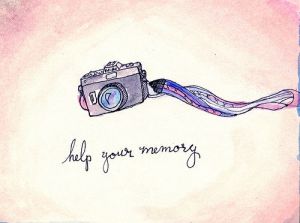
Right in the beginning of Chapter 7, Dr Luttrell says, “visual content allowing for companies to show, not tell, about their brands, business, and story. I really love this quote because this really sums up how pictures have added that visual pieces that most people need in order to be more informed, loyal, and active with a company. As i was thinking about pictures, it made me realize that they have both a positive and negative side, but yet this could be good either way. The evolution of pictures allows us to do things we were never capable of doing before.
Most people have heard the saying, a picture is worth a thousand words, and I truly believe that. In the modern day of social media, most companies have multiple outlets to reach their consumer. Most companies have Facebook, Twitter, or LinkedIn to share whats happening in the company or interact with customers. The new trend that is happening with companies is that they are picking up on social media sites that are only focused on pictures. The two main sites that companies use to connect on strictly a visual level is Instagram and Flickr, but lets not forget everyones favorite obsession Pinterest. Lets be honest here, most don’t want to admit it but we spend hours on either one of these sites or all of them. Not only is it for personal use but also but for companies as well. This is such an important tool for branding and making a personal impression on your consumer. These sites allow for customers to share things about the company and make a connection. These connections can be made from consumer to consumer about a product, consumer to company, or company to consumer.
Like all good things, there is a dark side. Photo sharing can have its ups and downs for both personal use and company use. But is there a clear argument about whats good and whats bad? As we have talked about in class, with praise comes criticism and that can shine through on photos. When photos are posted to a company site, they are mostly going to be something positive or innovative about whats happening in the company. Then again there are those few instances where trouble arises throughout a company and that could be posted on such sites as Instagram or Flickr. Some issues need to be brought to the surface, and pictures can help the situation or hinder it. All around though, I have come to the conclusion that pictures are one of the most important aspects for a company and an individual to connect.
I think its truly amazing how much pictures effect a company, and how it has evolved over such a short period of time. I don’t even remember the dinosaur days of companies handing out brochures to people to get a better visual look at their company, for a wide variety of things. Seriously, now that I think about it, I don’t think I have ever received a brochure in my 20 years, have you? The magic of a photo is that anyone can take a moment in time, freeze it and use to their endless possibilities. Its a beautiful thing.


While reading your blog post, I liked what you said about pictures and how pictures are used by companies as a different media to use. When thinking about this, I know that I am more likely to stop and read an article or ad about a certain company if the cover picture is bright and causes me to think. I also like how you said that through pictures a brand can create a personal impression of their consumers; this is totally accurate. When brands and companies effectively use a variety of different pictures besides their logo or products it helps to further pull consumers in. We talked about how in class Starbucks is a good example of the 80/20 rule and using other types of pictures than just a Pumpkin Spice Latte. Another thing I really enjoyed was how you talked about the bad use of pictures by brands. I work at Applebee’s and because of this class have looked at Applebee’s Instagram, Twitter, and Facebook page. Applebee’s doesn’t effectively use pictures, they just pictures of their food. Overall, I feel that pictures are a medium that companies are just beginning to use and some are better than others. With this in mind it is important to remember as future PR practitioners that a picture is worth a thousand words and with that being said you don’t want a picture to overshadow your story or brand you need to find a nice median.
You made a great point on the 80/20 rule, because it does apply to pictures as well as writing. Pictures have such a strong voice within a company, and can go positively or negatively. I really liked your point about not letting pictures overshadow your story. That is such a great point that I didn’t really think about when I was writing my blog. It so important to have an even balance of both within either a blog, company cite, or other outlet. I really enjoy photos, and would rather look than read but if there are to many photos it takes away the importance and impact pictures have for a company. It is very apparent right off the bat that companies either handle images great or fail. Its a hard thing to do, find that medium, as you said. It will be interesting to see how pictures progress over time.
I agree with you that pictures can have both pros and cons. I think you need to have the right balance of pictures and writing. I think pictures are good for certain sites; for instance, when I’m scrolling through my Twitter feed, I am more likely to stop and read something that has a picture. The pictures catch my attention in a never-ending feed of what can seem like random crap. Pinterest thrives on the use of pictures, and without pictures, I don’t think it would work as well. I think pictures help when sharing things. I don’t usually pay any attention to things people share on Facebook or Twitter if it’s just a lot of words. I definitely agree that there are some negative sides to the use of pictures. I think using pictures can lead to disappointment from the consumer, as we saw in the McDonalds video that we watched in class. It’s no secret that the fast food we buy never looks like the food in the ads. I think that can also be said for clothes that we see on Pinterest or even a couch that we see in a catalog. The McDonalds video really opened my eyes to see how much work goes into making sure products look fantastic in ads, and that it kind of sets consumers up for disappointment.
week7r
I couldn’t agree more with about stopping a pictures more than you would seeing something long without an sass, such as a picture. I find that its hard to have the right amount of images and images that fit for the certain outlet. The last half of your comment is seriously spot on, I really couldn’t agree more. Pinterest for sure, and that McDonald’s example too. So much work goes into almost tricking our minds into what this product is, and in reality its just not. Its such a letdown for some things. Pictures often are very deceiving, and in companies that could really hurt them. There will always be a positive and negative side to pictures, its all about how your handle them.